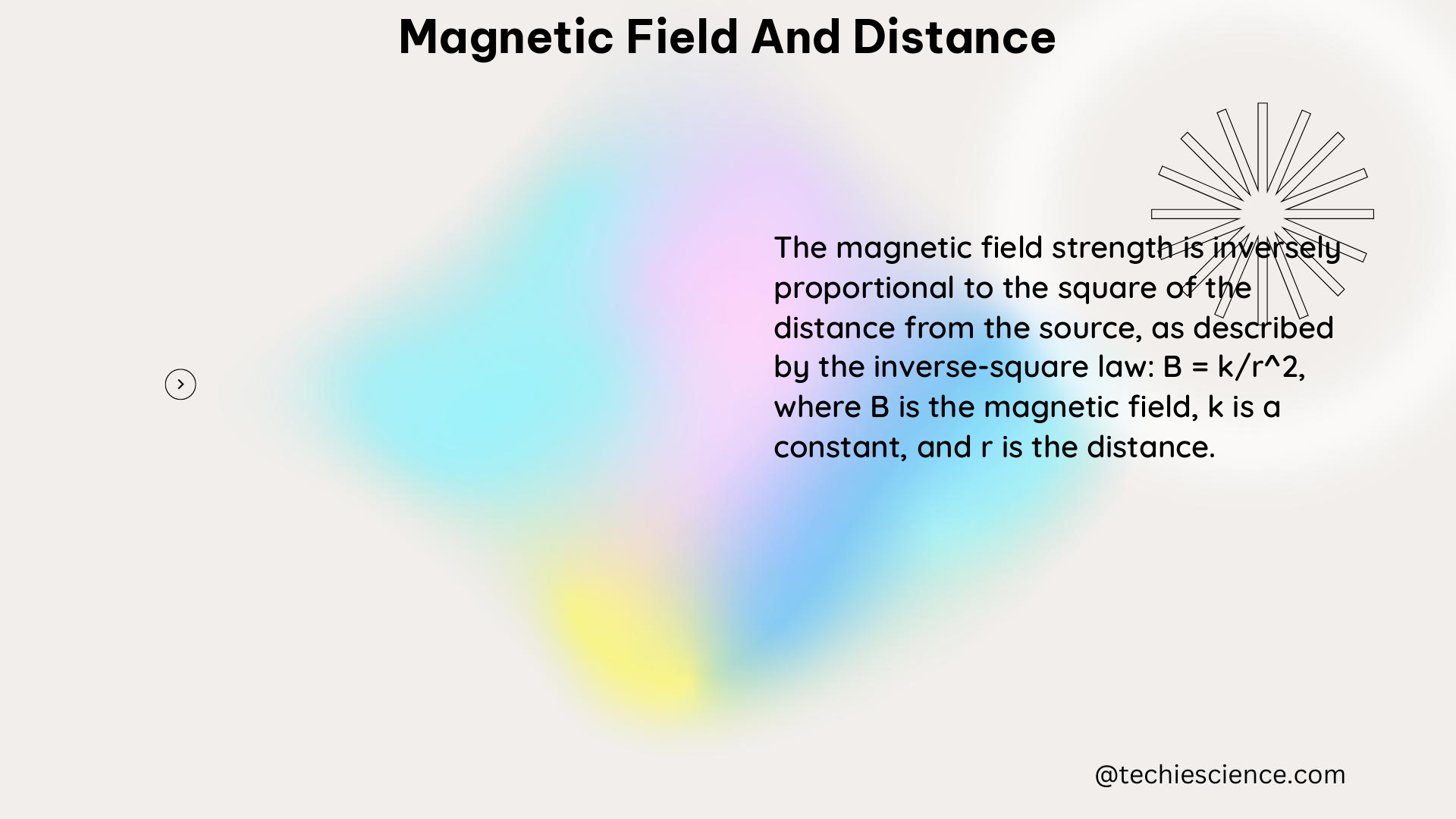Magnetic field and distance are closely related, with the strength of a magnetic field decreasing as the distance from its source increases. This relationship can be quantified through various experiments and calculations, providing a deeper understanding of magnetism and its properties.
Understanding the Inverse Square Law of Magnetic Fields
The relationship between magnetic field strength and distance is governed by the inverse square law, which states that the magnetic field strength is inversely proportional to the square of the distance from the source. This can be expressed mathematically as:
B = k / r^2
Where:
– B is the magnetic field strength
– k is a constant that depends on the source of the magnetic field
– r is the distance from the source of the magnetic field
This means that as the distance from the source of the magnetic field increases, the field strength decreases exponentially. For example, if you double the distance from the source, the magnetic field strength will decrease by a factor of four.
Measuring Magnetic Field Strength with a Gaussmeter

One way to measure the magnetic field strength and its relationship with distance is by building a gaussmeter. This involves creating a circuit that can measure the strength of a magnetic field and observing how the field strength changes with distance.
The basic steps to build a gaussmeter are:
- Obtain a Hall effect sensor, which is a device that can measure the strength of a magnetic field.
- Create a circuit that can convert the voltage output of the Hall effect sensor into a reading of the magnetic field strength.
- Calibrate the gaussmeter by placing it in a known magnetic field and adjusting the circuit to display the correct field strength.
- Take voltage readings at different distances from a magnet and use the sensor’s sensitivity and Equation 1 to convert these readings to magnetic field strength.
- Plot the magnetic field strength against distance to visualize how the field strength changes with distance.
By following this process, you can create a custom gaussmeter and use it to explore the relationship between magnetic field strength and distance.
Measuring Relative Magnetic Field Strength with a Compass
Another way to measure the relationship between magnetic field strength and distance is by using a compass and a permanent magnet. This method involves:
- Placing the permanent magnet at selected distances from the compass.
- Measuring the deflection of the compass needle at each distance.
- Calculating the relative magnetic field strength using the formula:
Relative Magnetic Field Strength = tan(θ)
Where θ is the angle of deflection of the compass needle.
- Plotting the relative magnetic field strength against distance to create a mathematical model of the relationship.
This activity helps students think more deeply about magnetism and the modeling of fields while practicing data collection and analysis.
Investigating the Force Needed to Separate Magnets
Another experiment that can provide insights into the relationship between magnetic field strength and distance is investigating the force needed to separate magnets. This involves:
- Placing two magnets in contact with each other.
- Measuring the force required to pull the magnets apart at different distances.
- Plotting the force against the distance between the magnets.
This can provide a more hands-on approach to understanding the relationship between magnetic field strength and distance, as the force required to separate the magnets is directly related to the magnetic field strength.
Analyzing Precompiled Data on Magnetic Field Strength and Distance
If you don’t have the resources to conduct your own experiments, you can also use precompiled data sets to explore the relationship between magnetic field strength and distance. One such data set is available from Education.ti.com.
This data set includes measurements of magnetic field strength at various distances from a magnet. You can use this data to:
- Predict the functional form of the magnetic field strength vs. distance relationship.
- Carry out a power regression to determine the relationship’s form.
- Use the resulting equation to calculate the magnetic field strength at any distance from the magnet.
By analyzing this precompiled data, you can gain a deeper understanding of the mathematical relationship between magnetic field strength and distance.
Additional Resources and Experiments
Here are some additional resources and experiments that can help you further explore the relationship between magnetic field strength and distance:
- Measuring Magnetic Fields with a Smartphone: This video demonstrates how to use a smartphone’s magnetometer to measure magnetic field strength and observe its relationship with distance.
- Magnetic Field Mapping: This Science Buddies project guide explains how to create a magnetic field map by measuring the field strength at various points around a magnet.
- Magnetic Field Visualization: This activity from TeachEngineering allows students to visualize the magnetic field around a magnet using iron filings or a compass.
- Magnetic Force and Distance Experiment: This Physics Forums thread discusses an experiment that investigates the relationship between the force needed to separate magnets and the distance between them.
By exploring these resources and conducting your own experiments, you can gain a deeper understanding of the fascinating relationship between magnetic field strength and distance.
Reference:
- https://www.sciencebuddies.org/science-fair-projects/project-ideas/Elec_p030/electricity-electronics/measure-magnetic-fields
- https://www.teachengineering.org/activities/view/rice_magnetic_activity1
- https://www.physicsforums.com/threads/magnet-experiment-investigating-force-distance.880419/
- https://education.ti.com/~/media/BAA91BA517884F8EB03FC0744005BA74
- https://www.youtube.com/watch?v=6ZQm081iUBw
Hi…I am Ankita Biswas. I have done my B.Sc in physics Honours and my M.Sc in Electronics. Currently, I am working as a Physics teacher in a Higher Secondary School. I am very enthusiastic about the high-energy physics field. I love to write complicated physics concepts in understandable and simple words.